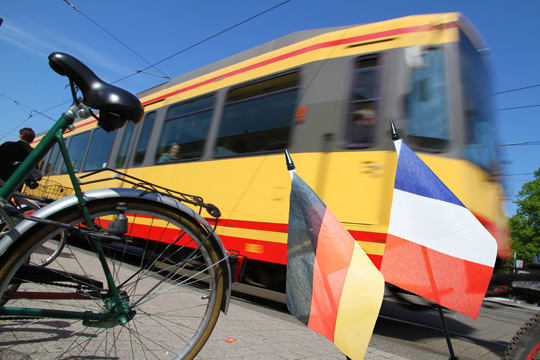Blueprint for sustainable mobility development
Freiburg, Nov 19, 2021
The German-French joint project SuMo-Rhine, which is coordinated by the Karlsruhe Institute of Technology (KIT), came to an end with a colloquium at the University of Freiburg on November 17. Nine project partners and more than 20 associated partners have worked over the past three years to improve the basis for sustainable mobility in the Upper Rhine region. The results, namely the “Municipal Information System for Sustainable Mobility,” could also point the way for other regions.

Successful collaboration: The French-German collaborative project SuMo-Rhine has generated knowledge and applications for more sustainable mobility in the Upper Rhine region. Photo: Lydia Albrecht, KIT
What do municipalities and regions need to develop the mobility sector sustainably? Using the example of the dynamic, trinational metropolitan region of the Upper Rhine, the University of Freiburg together with KIT, Strasbourg’s École d'architecture (ENSAS), the University of Strasbourg, the Centre national de la recherche scientifique (CNRS), the Université de Haute-Alsace, the University of Koblenz-Landau, and the City of Lörrach have now answered this question. In the joint project “SuMo-Rhine - Promoting Sustainable Mobility in the Upper Rhine Region,” they developed, among other things, the data-driven Municipal Information System for Sustainable Mobility (KINaMo). KINaMo records and evaluates municipal mobility options under 61 aspects (indicators). At the same time, it shows how the transportation options can be made more sustainable - that is, safer, more economical, more environmentally friendly and more in line with demand.
With the support of the online geodata service HERE, for the first time it was possible to provide municipalities and the public with the necessary empirical data - for example, on timetables, traffic infrastructures, noise and pollution levels or accident statistics - in a continuous, comparable and automated manner. “With SuMo-Rhine, the Upper Rhine region could become a blueprint for the sustainable mobility development of other European border regions,” says Professor Wolf Fichtner, head of the French-German Institute for Environmental Research at KIT and leader of the project, which ended after three years.
In addition to the development of KINaMo, empirical analyses were carried out. These provide information about political agendas and challenges in the Upper Rhine region. It became clear that transportation policy measures at the municipal level focus on shifting transportation demand to more environmentally friendly modes of transportation. Traffic avoidance, on the other hand, plays only a subordinate role. The study also examined the choice of transportation mode for commuting to work, the reasons for this choice and, depending on the situation, the traffic-related perception of the corona crisis. Finally, these analyses allow a comparison between Germany, France and Switzerland, the three countries in the Upper Rhine region.
Local and cross-border applications
In the second key field of action in the project, the new indicator system was tested and optimized in real contexts. One setting was Lörrach in southern Baden, which faces particular mobility challenges due to its valley location just outside Basel. During the development of KINaMo, urban practitioners contributed the municipal perspective from the very beginning.
The example of the city of Strasbourg, on the other hand, was used to evaluate urban development projects - with the help of a model based on the indicator system. The researchers developed two different sustainable mobility scenarios for the Eurometropolis of Strasbourg in order to test the value of the indicator system for the evaluation of future designs. In the sub-project “SuMo Atlas,” a mapping was created, also based on the indicator system, which shows the current mobility status in the Upper Rhine.
Finally, one notable project of cross-border mobility that was analysed was a tramway line that went into operation in 2017 and connects the Swiss city of Basel and the French municipality of St. Louis, about five kilometers away. “In the Upper Rhine region, cross-border mobility is not a rare phenomenon and should not be a barrier to sustainable mobility concepts,” notes Nora Baumgartner (DFIU), the project’s scientific coordinator. “Especially in border regions, we need to develop synergies, leverage opportunities and strive toward common lessons learned in order to work towards reducing environmental impact.“
For more information:

